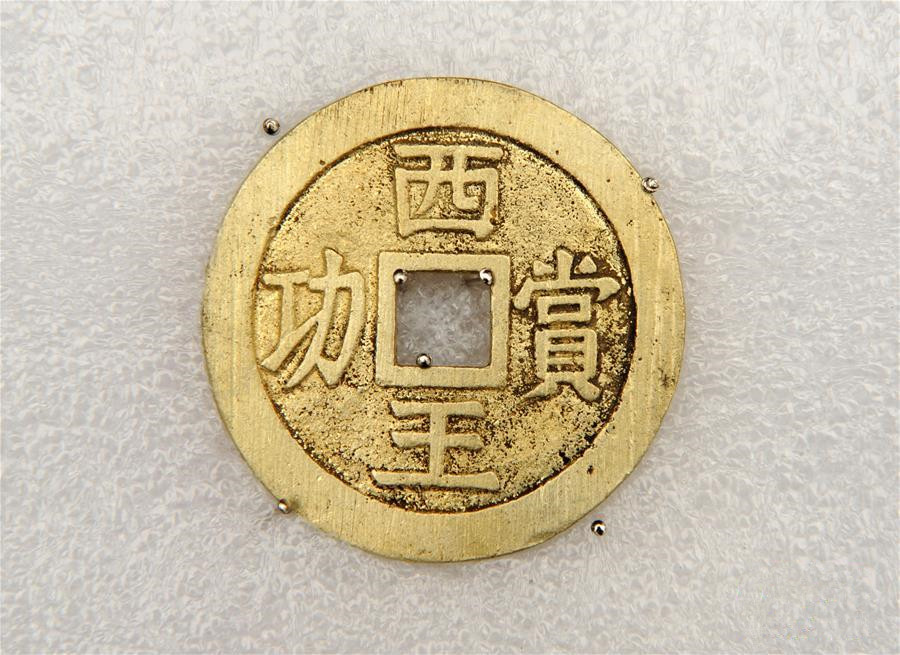Sunken treasure discovery has far-reaching implications

The picture shows a gold coin excavated from the sunken treasure site. The four Chinese characters “Xi Wang Shang Gong” inscribed on the coin literally means “awarded by the king of the Daxi Dynasty for meritorious military service.” It was minted under the instructions of the Ming-Dynasty peasant revolt leader Zhang Xianzhong, who styled himself as the king of the Daxi regime. (PHOTO: XINHUA)
Archaeologists said the discovery of an ancient rebel leader’s sunken treasure in Southwest China’s Sichuan Province will have a significant impact on a number of areas of historical studies.
They evaluated the archaeological feat at a recent briefing in Meishan, Sichuan Province, on the underwater excavations at Jiangkou, a section of the Minjiang River in Pengshan County. It was the first underwater excavation ever attempted in the province.
The first stage lasted from Jan. 5 to April 12. After more than three months of underwater digging, archaeologists have unearthed nearly 30,000 relics.
Judging from the characters carved on some relics, researchers concluded that they were from the Daxi regime established by Zhang Xianzhong, leader of a peasant uprising at the end of the Ming Dynasty (1368-1644).
According to legend, Zhang was defeated by Ming soldiers while attempting to transfer his large haul of treasure southward. Around a thousand boats loaded with money and assorted valuables were said to have sunk in the battle. The rich findings suggest that there may be some truth to the legend.
Gao Dalun, president of the Sichuan Provincial Cultural Relics and Archaeology Research Institute, noted that the dig yielded fruitful results, securing a complete chain of evidence on sunken boats and the battlefield.
“The discovery of sunken treasure is not only a big deal for the archaeological community but is also of great significance to historians studying the Ming Dynasty,” said Shang Chuan, president of the Chinese Society on Ming Dynasty History and a research fellow from the Institute of Archaeology at the Chinese Academy of Social Sciences.
It is a perfect integration of the double evidence law into historical research, Shang said.
After a recent visit to the excavation site, Chen Shisong, a research fellow at the Sichuan Academy of Social Sciences, said that the findings have substantially enriched research on the history of Sichuan Province in the Ming Dynasty.
“It is not only conducive to deepening the understanding of historical facts related to the rebel leader Zhang Xianzhong but also sheds light on the political and tax systems of the Ming Dynasty,” Chen said. “The unearthed objects, many of which are unprecedented, have provided solid evidence about social life in the late Ming.”
Zhang Xianzhong, a research fellow from the Institute of History from Tianjin Academy of Social Sciences, who coincidentally shares the same name with the rebel leader, said that the large quantity of excavated relics will undoubtedly further promote and deepen research on Sichuan history, silver monetization and the system of regional kings.
“The sunken relics offer the best point of departure for deeper analysis of the history of dynastic change from the Ming to Qing Dynasty (1616-1911),” Chen said. “Although the treasure was sunken by Zhang Xianzhong, we shouldn’t focus only on Zhang. Instead we should put him in the broader context of dynastic change to observe all that was happening in all regions as well as their relevance.”
Chen suggested creating a high-level academic platform and research base focused on the Ming-Qing dynastic change, thereby connecting the academic circles of Ming and Qing history at home and abroad while guiding the research of social history in southwest China.
Liu Zhiyan, head of underwater archaeology at the the Sichuan Provincial Cultural Relics and Archaeology Research Institute and leader of the project for sunken treasure excavations, said the research team will organize, repair and protect the recovered objects as part of the next step.
Also they will carry out extensive geographical prospecting to find an area suitable for the storage of sunken relics, Liu said. Systematic archaeological investigations into the upstream and downstream areas of the excavation site have been scheduled to provide clues for identifying the range of the site and the area to be dug in the following year, with work planning for 2018 underway, he added.
Zeng Jiang is a reporter at the Chinese Social Sciences Today.

 PRINT
PRINT CLOSE
CLOSE